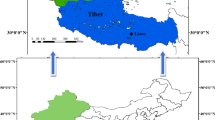Abstract
With the development of vegetation indices, the reflection capability of vegetation indices to the state of vegetation has been improved in various degrees. Especially, the vegetation index of Terra/MODIS-EVI is believed to have the highest sensitivity to the seasonality of vegetation. This study compares the reflection susceptibility of three vegetation indices (NOAA/AVHRR-NDVI, Terra/MODIS-NDVI and Terra/MODIS-EVI) to the seasonal variations of vegetation in the mid-south of Yunnan Province of China. It has been found that Terra/MODIS-EVI does best in the elimination of external disturbance. Firstly, it obviously improves the linear relationship with vegetation cover degree, especially in the high vegetation coverage area. Secondly, it avoids the emergence of vegetation index saturation. Thirdly, it reduces the environmental influence including both effects of atmosphere and soil. So it is believed that the Terra/MODIS-EVI can offer excellent tool for quantitative research of remote sensing, and has realized to be oriented by data with high quality.
Similar content being viewed by others
References
Ai Tinghua, Liu Yaolin, 2003. Spatial relation resolution and spatial relation abstraction. Geo-spatial Infomation Science, 6(4): 10–16.
Chen Longxun, Zhu Qiangen, Luo Huibang et al., 1991. East-Asia Monsoon. Beijing: China Meteorological Press, 49–60. (in Chinese)
Chen Xiaoqiu, Hu Bing, Yu Rong, 2005. Spatial and temporal variation of phenological growing season and climate change impacts in temperate eastern China. Global Change Biology, 11: 1118–1130.
Chen Yunhao, Li Xiaobing, Xie Feng, 2001. Study on surface Albedo distribution over Northwest China using remote sensing technique. Scientia Geographica Sinica, 21(4): 327–333. (in Chinese)
Cheng Qian, 2006. Multisensor comparisons for validation of MODIS vegetation indices. Pedosphere, 16(3): 362–370.
Chenoweth M S, 2003. Developing a spatial database for the interpretation of Karst landscape and vegetation in the Jamaican Cockpit Country. Milwaukee: University of Wisconsin-Milwaukee.
Gao X, Huete A R, Ni W et al., 2000. Optical biophysical relationships of vegetation spectra without background contamination. Remote Sensing of Environment, 74(2): 609–620.
Gong Huili, Li Jing, Zhao Wenji et al., 2004. The technical framework of multi-source remote sensing data mining. Journal of Systems Science and Information, 2(3): 509–516.
Guo Ni, 2003. Vegetation index and its advances. Arid Meteorology, 21(4): 71–75. (in Chinese)
Huete A R, Didan K, Miura T et al., 2002. Overviews of the radiometric and biophysical performance of the MODIS vegetation indexes. Remote Sensing of Environment, 83: 195–213.
Huete A R, Didan K, Shimabokuro Y et al., 2000. Regional Amazon Basin and global analysis of MODIS vegetation indices: Early results and comparisons with AVHRR. Proceeding of IGARSS, 6(2): 536–538.
Huete A R, Liu H, Batchily K et al., 1997. A comparison of vegetation indices over global set of TM images for EOS-MODIS. Remote Sensing of Environment, 59(3): 440–451.
Jiang Dong, Wang Naibin, Yang Xiaohuan et al., 2003. Study on the interaction between NDVI porfile and the growing status of crops. Chinese Geographical Science, 13(1): 62–65. DOI: 10.1007/s11769-003-0084-4
Justice C, Belward A, Morisette J et al., 2000. Developments in the ‘validation’ of satellite sensor products for the study of the land surface. International Journal of Remote Sensing, 21(17): 3383–3390.
Justice C, Vermote E, Townshend J et al., 1998. The moderate resolution imaging spectroradiometer (MODIS): Land remote sensing for global change research. IEEE Transactions on Geoscience and Remote Sensing, 36(4): 1228–1249.
Li Linyi, Liu Zhaoli, Li Chunlin et al., 2002. Spatial correlation analysis of crop yield in the middle and west of Jilin Province. Chinese Geographical Science, 12(2): 182–185. DOI: 10.1007/s11769-002-0029-5
Liu H Y, Huete A R, 1995. A feedback based modification of the NDVI to minimize canopy background and atmospheric noise. IEEE Transactions on Geoscience and Remote Sensing, 33(2): 457–465.
Liu Liangming, Liang Yitong, Ma Huiyun et al. 2004. Relationship research between MODIS-NDVI and AVHRR-NDVI. Geomatics and Information Science of Wuhan Unviersity, 29(4): 307–310. (in Chinese)
Liu Yansui, Hu Yecui, Peng Liuying, 2005. Accurate quantification of grassland cover density in alpine meadow soil based on remote sensing and GPS. Pedosphere, 15(6): 778–783.
Liu Yujie, Yang Zhongdong, 2001. The Principle and Arithmetic of MODIS Data. Beijing: Science Press, 232–249. (in Chinese)
Piao Shilong, Fang Jingyun, 2003. Seasonal changes in vegetation activity in response to climate changes in China between 1982 and 1999. Acta Geographica Sinica, 58(1): 119–125. (in Chinese)
Qiang Xuemin, Ju Jianhua, Zhang Haohan, 1998. A diagnostic analysis of the summer monsoon in Yunnan. J. Yunnan Uni. (Natural Sciences), 20(1): 75–79. (in Chinese)
Shen Guangrong, Wang Renchao, 2001. Review of the application of vegetation remote sensing. Journal of Zhengjiang University (Aric. & Life Sec.), 27(6): 682–690. (in Chinese)
Tang Yanlin, Wang Renchao, Huang Jingfeng, 2004. Relations between red edge characteristics and agronomic parameters of crops. Pedosphere, 14(4): 467–474.
Wang Shengyue, 2002. Geography of Yunnan. Kunming: Yunnan Nationality Press, 46–48. (in Chinese)
Zhou Guangsheng, Wang Yuhui, Bai Liping et al., 2004. Study on the interaction between terrestrial ecosystems and global change. Acta Meteorological Sinica, 62(5): 692–708. (in Chinese)
Author information
Authors and Affiliations
Corresponding author
Additional information
Foundation item: Under the auspices of National Basic Research Program of China (No. 2003CB415101), Ph.D. Foundation of Henan Polytechnic University (No. B2006-11)
Rights and permissions
About this article
Cite this article
Hao, C., Wu, S. & Xu, C. Comparison of some vegetation indices in seasonal information. Chin. Geogr. Sci. 18, 242–248 (2008). https://doi.org/10.1007/s11769-008-0242-y
Received:
Accepted:
Published:
Issue Date:
DOI: https://doi.org/10.1007/s11769-008-0242-y




